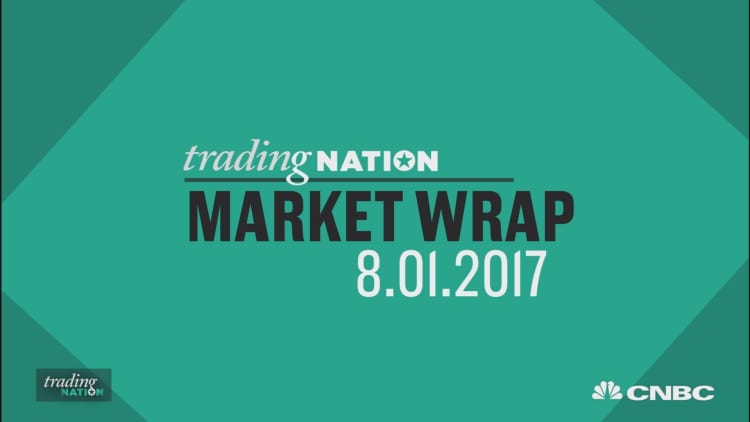
U.S. stocks closed higher on Tuesday, the first trading day of August, as the Dow Jones industrial average approached another milestone.
The 30-stock index rose 72.80 points close at a record of 21,963.92, with 3M and Goldman Sachs contributing the most gains. The Dow also came within 10 points of reaching 22,000. The S&P 500 advanced 0.24 percent to end at 2,476.35, with financials leading advancers. The Nasdaq composite also climbed 0.23 percent to end at 6,362.94.
Major U.S. Indexes
Dow futures briefly signaled the index would break above 22,000 for the first time. The Dow is coming off its strongest monthly performance since February, having risen 2.54 percent. Shares of Boeing contributed the lions share of the gains, adding more than 300 points to the index.
"This has been mostly earnings driven and the earnings have been terrific," said Crit Thomas, global market strategist at Touchstone Investments. "There's really no other way to describe it."
The Dow, along with the Nasdaq and the S&P, notched record highs in July as investors shrugged off news of the turmoil in Washington as well as geopolitical tensions. The White House is once again on Wall Street's radar after the recently appointed communications director Anthony Scaramucci was fired on Monday. He was in the position for 10 days.
"The market wanted to go up and did, posting five new closing highs in July, as it continued to watch the Floor, rather than the man or groups in Washington," Howard Silverblatt, senior Index analyst at S&P Dow Jones Indices.
Earnings season is well under way with most companies topping expectations. Seventy-two percent of the S&P 500 companies that had reported as of Tuesday morning had beaten bottom-line estimates, while 69 percent had beaten on the top line, according to Thomson Reuters I/B/E/S.
That said, The Earnings Scout CEO Nick Raich pointed out Tuesday that the overall earnings growth this season is below that of the previous one.
"What's more, based on current expectations and revision trends, growth is likely to decelerate more over the next two quarters," Raich said in a note to clients. "Therefore, we are maintaining our recommendation to underweight global stocks by 5% of your normal strategic allocation."
Earnings season continues Tuesday with tech giant Apple set to report after the close. Athletic apparel firm Under Armour reported better-than-expected quarterly results before the open, but the company's stock fell 8 percent on weaker-than-expected guidance.
Investors also turned their eyes to a slew of economic data on Tuesday. The IHS Markit manufacturing PMI hit its highest level in four months in July, while U.S. construction spending declined 1.3 percent in June.
U.S. personal income for June remained unchanged, below an expected increase of 0.3 percent.
Later this week, the U.S. Labor Department will release its monthly employment data. The report is often considered the most important economic report of the month.
"Figures on employment and capital spending over the coming month will give us a better sense of what second-quarter profits really mean - beyond whether they beat Wall Street estimates, a dubious distinction at best," Steve Blitz, chief U.S. economist at TS Lombard, said in a note.
Investors will examine every piece of economic data this week for clues about the Federal Reserve's next monetary policy move. Market participants aren't expecting the Fed to raise rates again this year until December, but the central bank has hinted it could start rolling off its massive $4.5 trillion balance sheet in September.
U.S. Treasury yields traded lower Tuesday, with the 10-year yield at 2.257 percent and the two-year yield near 1.347 percent.
The dollar skidded to a six-week low versus the yen, its outlook clouded by U.S. political turmoil and doubts over whether there will be another Federal Reserve rate hike this year.
The dollar slipped to a low of 110.005 yen at one point, its lowest level since June 15. The greenback was last trading at 110.26 yen, flat on the day.
—Reuters contributed to this report.



